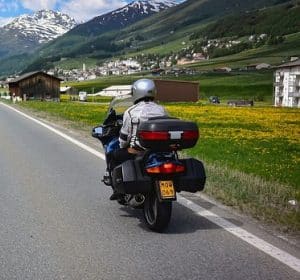Over the years, we have witnessed a decline in motorists’ use of hand signals. From my riding experience, I can attest to the critical need of all road users to learn these signs for their safety and those of other road users. Even though all bikes come with turn signals, these two combined enhance safety. The rate of motorcycle crashes is 29 times higher than vehicles, thus the increasing need for safety among riders.
Riders don’t have to use hand signals on a motorcycle. However, the law requires them to signal when turning. Hand signals can be your only way of communication if your turn signals fail. Using these two can make your message more obvious to other road users.
Most road users, including motorists, are unfamiliar with motorcycle hand signals. The availability of turn signs doesn’t make these traditional signals irrelevant. If you have been riding a motorcycle, you know what happens when your turn signs fail and you cannot communicate with other motorists. I prepared this post to shed light on this widely ignored critical road practice and its relevance to your safety. Read on to discover these and more.
Must You Use Hand Signals- What Does the Law Say?
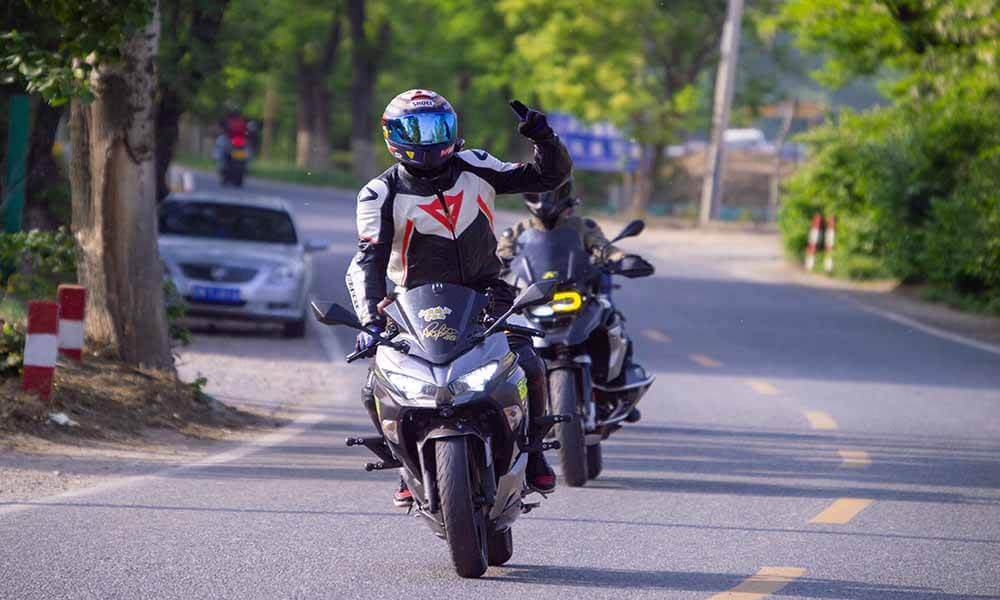
Hand signals are critical not only for riders but also for all other road users. Besides, it would be useless if drivers and pedestrians didn’t understand this form of communication. Hand signals are used by bikers as a warning when stopping or turning. They also increase your visibility to other road users, including motorists and pedestrians.
Riders Have a Legal Responsibility to Signal
It wasn’t until 1973 that motorcycles’ turn signals were invented. Models manufactured before then used hand signals entirely. Bikers must signal when turning down or changing lanes, failure to which they could be legally liable. Studies show that countless accidents occur from failure to signal. In such cases, the rider is considered negligent.
The legal requirements for motorists vary from one state to the next. Motorcycles should have a turn signal light, brake light, rear reflections, one to three headlights, a taillight, and a registration plate light in most states. Regardless of your state, failure to signal is punishable by law.
In Texas, for instance, bikers don’t need to have turn signal lights to pass inspection. In some instances, your turn signals system can break down without your knowledge. And without a signal, other road users cannot predict your direction. The risk of a crash is very high in such a case. It is, therefore, wise for a rider to use both hand and turning signals while riding.
Motorists who fail to signal risk their lives and other road users. In case of a crash and evidence suggests you didn’t use a signal, you are liable for negligence. Police officers who respond to the incident try to establish the cause of the accident by collecting evidence in footage and eyewitness statements. Once proven in court, the rider could have to compensate the injured party depending on the form of injuries and damages incurred.
Motorcycle Hand Signals
Hand signals are standard and should be used on the left side of your motorcycle. Since vehicles in the US are driven on the left side, signaling on the left side, it is easier for motorists behind you to see. Also, as you use your left hand, the other hand should remain on the throttle.
There are essential signals for road use and a group of dedicated hand signals for several bikers riding together. If you are riding in a group, it is always best to agree on the signals you will use and ensure each rider is conversant with them. Remember to keep the signals simple and polite for effective communication.
This section will look at the different types of motorcycle hand signals in each category and how you can use them for your safety.
Essential Motorcycle Signals
-
Right Turn
To signal a right turn, extend the left arm and bend the elbow at a 90° angle with your fist clenched. Even if you are making a right turn, remember to use your left arm when signaling.
-
Left Turn
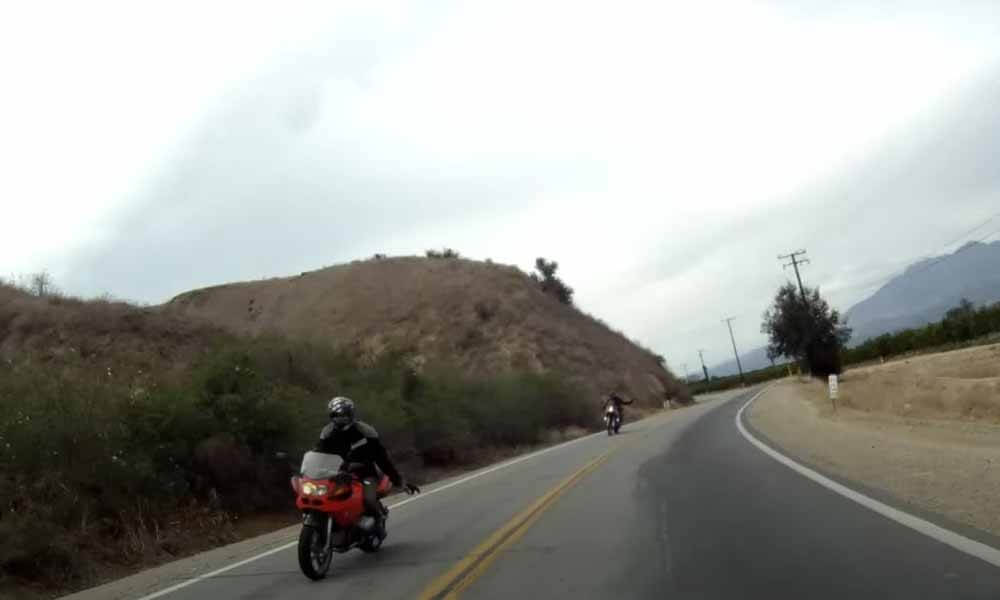
Whenever you intend to make a left turn, you signal other road users by extending your left arm and pointing your palm downwards. This signal is simple and easy as you are using your left arm directed in the direction of turning.
-
Stop
If you want to notify other road users you are stopping, extend out your left arm and bend it downwards at the elbow. Let your palm face backward in the direction of the motorists behind you.
-
Turn Signal On
If you need to make a “blinking” gesture, use your left arm fingers to create this motion by closing and opening them.
-
Hazard In the Roadway
To signal to other motorists of obstruction ahead, signal using your left hand and foot. Extend your left arm with your index figure pointed to the ground. Also, extend your right foot pointing towards the ground. The signal is used to warn other motorists of accidents such as accidents.
Motorcycle Signals For Group Riders
Here are some signs you can use when riding in a group:
-
Speed Up
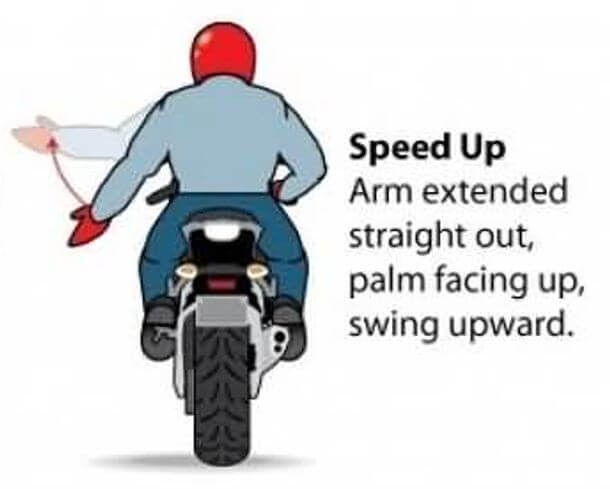
If you want to signal your fellow riders to pick up the pace, extend your left arm with your palm facing up and indicate an upward motion.
-
Slow Down
To signal other riders to lower their speed, extend your left arm and do a downward movement with your palm facing down.
-
Follow Me
For other riders in your group to follow you, signal them by extending your left arm upward with your palm facing forward.
-
Single File Line
For a single lineup, extend your left arm up with your index finger pointed upwards. It is best to signal ahead of time to allow each rider sufficient time for the lineup as required.
-
Double File
If you want to signal other riders in your group to form two lines, extend your left arm upwards with your index and middle fingers pointing upwards.
-
You Take the Lead/Come
To have someone else lead the group, signal them by extending your left arm at a 45° angle, index finger pointed, then wave from front to back.
-
Pull-Off
When you need your group to leave simultaneously, signal them by extending your left arm and waving it vertically towards your body.
-
Fuel Stop
To communicate fuel, stop to your group, extend your left hand, and point towards your bike’s fuel tank with the index finger.
-
Comfort Stops
If you intend to signal your group to take a break, extend your left arm with your hand closed into a fist and wave it up and down.
-
Refreshment Stops
When it is time for refreshment, you can signal your group by taking out your left arm, closing your fist, and directing the thumb to the mouth.
-
Police Up Ahead
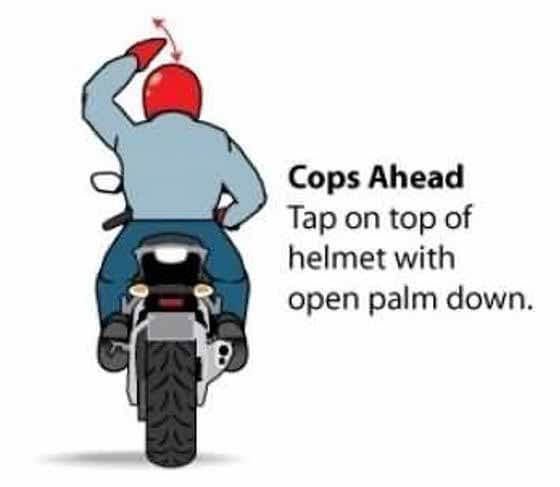
You may also want to notify your group of police ahead. To do so, extend your left arm upwards and tap on the top of your helmet with your palm facing down. This sign has a double meaning as, for some, it could be to warn oncoming traffic that their high beams are on.
-
Kill Your Engine
To signal other motorists to kill their engines, the leader can use their left hand to perform a slicing action across their throat.
You May Also Like:
How to Ride a Motorcycle for the First Time?
Here Are Some Tips for Effective Hand Signaling
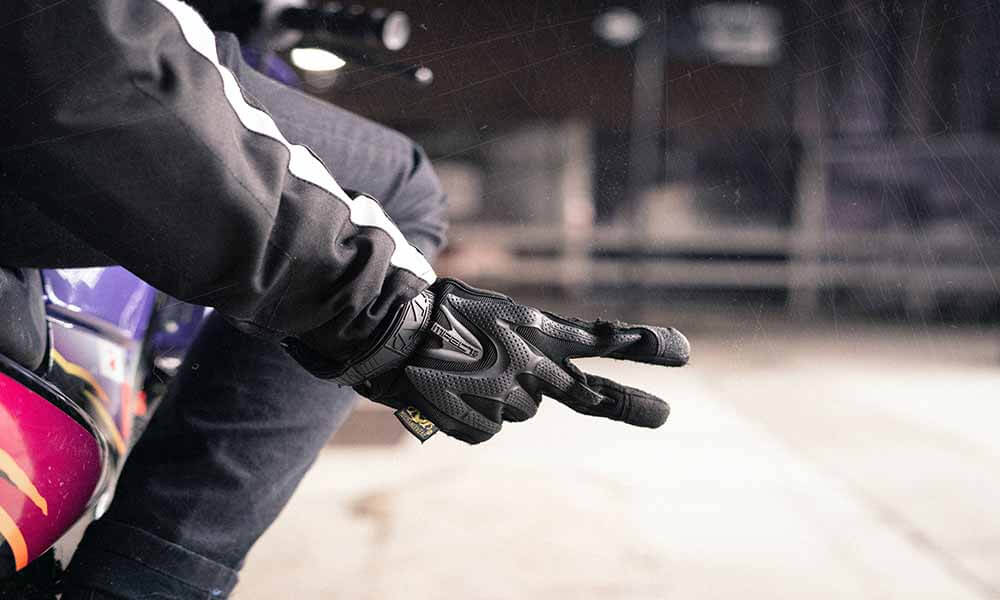
Hand signals are used to enhance safety on the road. For this reason, you need to master and perform the signs correctly. Remember that any left-hand movement can mean something else to other road users.
Tips:
- When signaling, always make big movements to maximize visibility for distant motorists. Keep in mind that speed may affect visibility.
- Study these hand signals and observe proper positioning for clear communication. It is important to learn all signs, even those used by vehicles.
- Perform these signals 200ft before making the intended action to allow other road users enough reaction time. It is also a legal requirement in some states.
- Prioritize your safety when performing these signals. Before extending your arm, always check your rear mirror for approaching motorcycles or vehicles.
- Statistics show that 40% of motorcycle accidents in the US occur from sudden turns. It is, therefore, best to slow down and hold your arm in position until you complete a turn.
Final thoughts: Do You Have to Use Hand Signals on a Motorcycle?
Even with turn signals, hand signs are still relevant on the road. They are advantageous in that they communicate a wider range of messages than the turn signals on your bike. All road users should be aware of these signs because some motorists frequently use them. As you learn them make sure to practice often to use them accurately.
WR/GM


